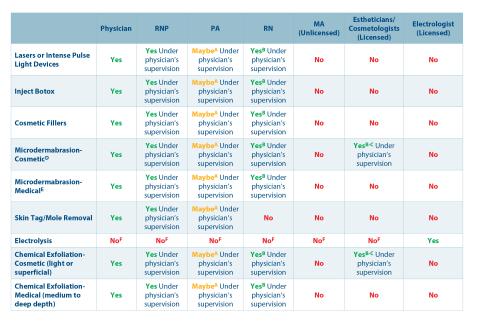A medical spa is a cross between a traditional day spa and a medical clinic. Medical spas are run under the supervision of a medical doctor. Here in sunny California, cosmetic procedures have always been popular and now, with the rise in popularity of the medical spa business (commonly referred to as med spa), more physicians have opted to expand their practices to include some of the more in-demand cosmetic services.
For many physicians, a venture into cosmetic services is a huge leap from their normal practice and they are finding themselves in unfamiliar territory and with many questions. One question we get frequently at CAP is related to scope of practice in a med spa. In other words, who can do what?
To help our members in this regard, we have compiled a quick reference guide regarding scopes of practice in a physician owned and operated med spa in California.

A. Physician Assistants may perform dermatologic or cosmetic procedures under the supervision of a licensed physician only if dermatology or cosmetic medicine, respectively, is a part of the supervising physician’s customary practice.
B. MD/RNP/PA must first perform an examination of the patient before delegating this task to ensure the patient is an appropriate candidate for the desired treatment.
C. For the esthetician or cosmetologist, physician supervision is not typically required for these procedures; however, in the physician-owned med spa setting, physician supervision of all staff is necessary.
D. Cosmetic microdermabrasion only affects the outermost layer of the skin or the stratum corneum.
E. Medical microdermabrasion penetrates to deep levels of the epidermis (treatments to remove scarring, blemishes, or wrinkles are considered medical treatments).
F. This treatment is not governed by the primary licensing board; additional training and licensure required.
Important Licensing and Coverage Considerations
It is important to remember that while cosmetologists and estheticians are licensed and trained in most cosmetic procedures, their licenses only allow them to perform superficial treatments that do not go beyond the outermost layer of the epidermis. In other words, they are prohibited from penetrating or injecting the skin, using lasers, or performing medical dermabrasion or medical skin peels. This also includes microneedling and dermaplaning, as these procedures are all considered medical treatments. These types of medical treatments may only be performed by a physician or qualified licensed medical professional – an RN, RNP, or PA under the supervision of a physician. Allowing a medical assistant or an esthetician to perform any of these medical treatments is parallel to aiding and abetting the unlicensed practice of medicine.
The most important factor to keep in mind is that the physician is ultimately responsible for supervision of the staff that he or she employs. This includes, but is not limited to, ensuring that staff is appropriately trained and/or licensed for the tasks they are to perform. In addition, the physician must provide direction, guidance, and ongoing evaluation of the staff that he or she oversees. It is good practice for physicians to continually review the supervision requirements of staff as the level and type of supervision varies depending on the individual licensing boards.
It is also very important to confirm CAP medical professional liability coverage for you, your workers, and entity. Under the MPT Agreement, claims are excluded for elected cosmetic procedures (except for the use of pharmaceuticals to treat the epidermal layer of the skin) unless the physician’s medical specialty is plastic surgery, dermatology, otolaryngology. Full details of this coverage exclusion are found in Part 1, Section 4.A.20.g of the MPT Agreement, which can be viewed online in the Member’s Section of www.capphysicians.com.
If you have or are planning to expand your practice to include med spa services, please contact CAP Member Services at 800-610-6642 or via email at ms@CAPphysicians.com to review your coverage needs to ensure you have adequate liability protection.
Cynthia Mayhan is a Senior Risk Management and Patient Safety Specialist for CAP. Questions or comments related to this article should be directed to cmayhan@CAPphysicians.com.
Sources
Medical Board of California (MD/PA/MA)
1. https://www.mbc.ca.gov/Download/Documents/medical-spas-business.pdf
2. https://www.mbc.ca.gov/Licensees/Cosmetic_Treatments_FAQ.aspx
4. https://www.mbc.ca.gov/Licensees/Physicians_and_Surgeons/Physician_Assistants_FAQ.aspx
California Board of Registered Nursing (RNP/RN)
5. https://www.rn.ca.gov/pdfs/regulations/npr-b-79.pdf
6. https://www.rn.ca.gov/pdfs/regulations/npr-i-25.pdf
Board of Barbering and Cosmetology (Estheticians/Cosmetologists)
7. https://www.barbercosmo.ca.gov/forms_pubs/publications/faqs.shtml#cs1
8. https://www.barbercosmo.ca.gov/consumers/medspa_factsheet.pdf
9. https://barbercosmo.ca.gov/forms_pubs/publications/exfoliation_safety.pdf
The American Med Spa Association